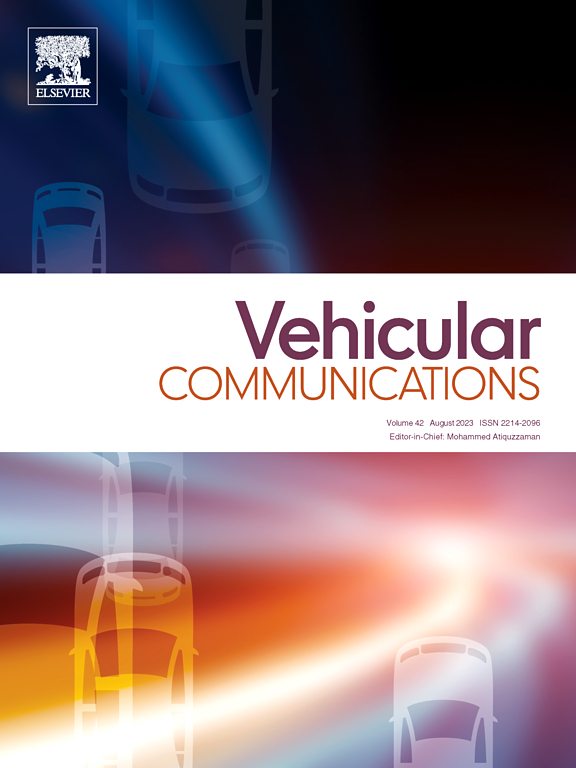Leveraging reputation for enhanced decision accuracy in vehicle-to-vehicle communications under limited infrastructure
IF 6.5
2区 计算机科学
Q1 TELECOMMUNICATIONS
引用次数: 0
Abstract
Vehicle-to-Vehicle (V2V) networking enhances transportation safety and efficiency by enabling vehicles to share alerts. However, malicious vehicles may inject false messages, leading to disputes. While certificates help ensure security, Certificate Revocation List (CRLs) may be outdated in low-connectivity areas, making it hard to verify conflicting reports. Reputation systems, using a pre-signature scheme, can aid decision-making even in infrastructure-limited environments.
In this paper, we provide the mechanisms to use reputation in areas with low/no connectivity, whilst allowing for pseudonymous certificates to verify message authenticity without breaking privacy. The approach is integrated into the existing Security Credential Management System (SCMS), a framework for managing digital certificates for secure V2V communication.
Our simulations evaluate the security performance of our proposed mechanism, with offline available reputation, against plain SCMS certificate management that rely solely on CRL to block malicious vehicles. The results are achieved by integrating vehicular simulation tools like SUMO, OMNeT++, and Veins, to evaluate the V2V communications in each system under two conditions (Accident and No accident) ensuring a comprehensive system evaluation.
The proposed scheme improves accuracy in decision-making with conflicting information by 36% in accidents and 44.4% in No-Accident situations in a rural environment.
在有限的基础设施下,利用车辆对车辆通信中提高决策准确性的声誉
车对车(V2V)网络通过使车辆共享警报来提高运输安全性和效率。然而,恶意车辆可能会注入虚假信息,导致纠纷。虽然证书有助于确保安全性,但证书撤销列表(crl)在低连接区域可能已经过时,因此难以验证冲突的报告。使用预签名方案的信誉系统即使在基础设施有限的环境中也可以帮助决策。在本文中,我们提供了在低连接/无连接区域使用信誉的机制,同时允许假名证书在不破坏隐私的情况下验证消息真实性。该方法集成到现有的安全凭证管理系统(SCMS)中,SCMS是一个管理数字证书的框架,用于安全的V2V通信。我们的模拟评估了我们提出的机制的安全性能,与仅依赖CRL来阻止恶意车辆的普通SCMS证书管理相比,具有离线可用声誉。结果通过集成SUMO、omnet++和vein等车载仿真工具,在两种情况下(事故和无事故)评估每个系统的V2V通信,以确保全面的系统评估。在农村环境中,该方案将信息冲突情况下的决策准确率提高了36%,在无事故情况下提高了44.4%。
本文章由计算机程序翻译,如有差异,请以英文原文为准。
求助全文
约1分钟内获得全文
求助全文
来源期刊

Vehicular Communications
Engineering-Electrical and Electronic Engineering
CiteScore
12.70
自引率
10.40%
发文量
88
审稿时长
62 days
期刊介绍:
Vehicular communications is a growing area of communications between vehicles and including roadside communication infrastructure. Advances in wireless communications are making possible sharing of information through real time communications between vehicles and infrastructure. This has led to applications to increase safety of vehicles and communication between passengers and the Internet. Standardization efforts on vehicular communication are also underway to make vehicular transportation safer, greener and easier.
The aim of the journal is to publish high quality peer–reviewed papers in the area of vehicular communications. The scope encompasses all types of communications involving vehicles, including vehicle–to–vehicle and vehicle–to–infrastructure. The scope includes (but not limited to) the following topics related to vehicular communications:
Vehicle to vehicle and vehicle to infrastructure communications
Channel modelling, modulating and coding
Congestion Control and scalability issues
Protocol design, testing and verification
Routing in vehicular networks
Security issues and countermeasures
Deployment and field testing
Reducing energy consumption and enhancing safety of vehicles
Wireless in–car networks
Data collection and dissemination methods
Mobility and handover issues
Safety and driver assistance applications
UAV
Underwater communications
Autonomous cooperative driving
Social networks
Internet of vehicles
Standardization of protocols.
 求助内容:
求助内容: 应助结果提醒方式:
应助结果提醒方式:


